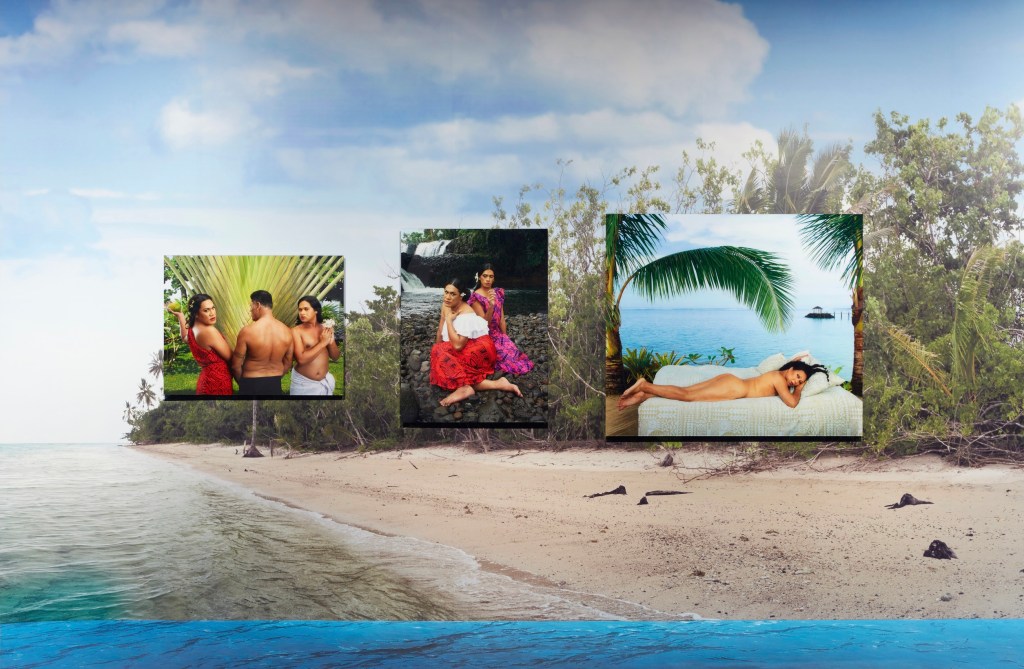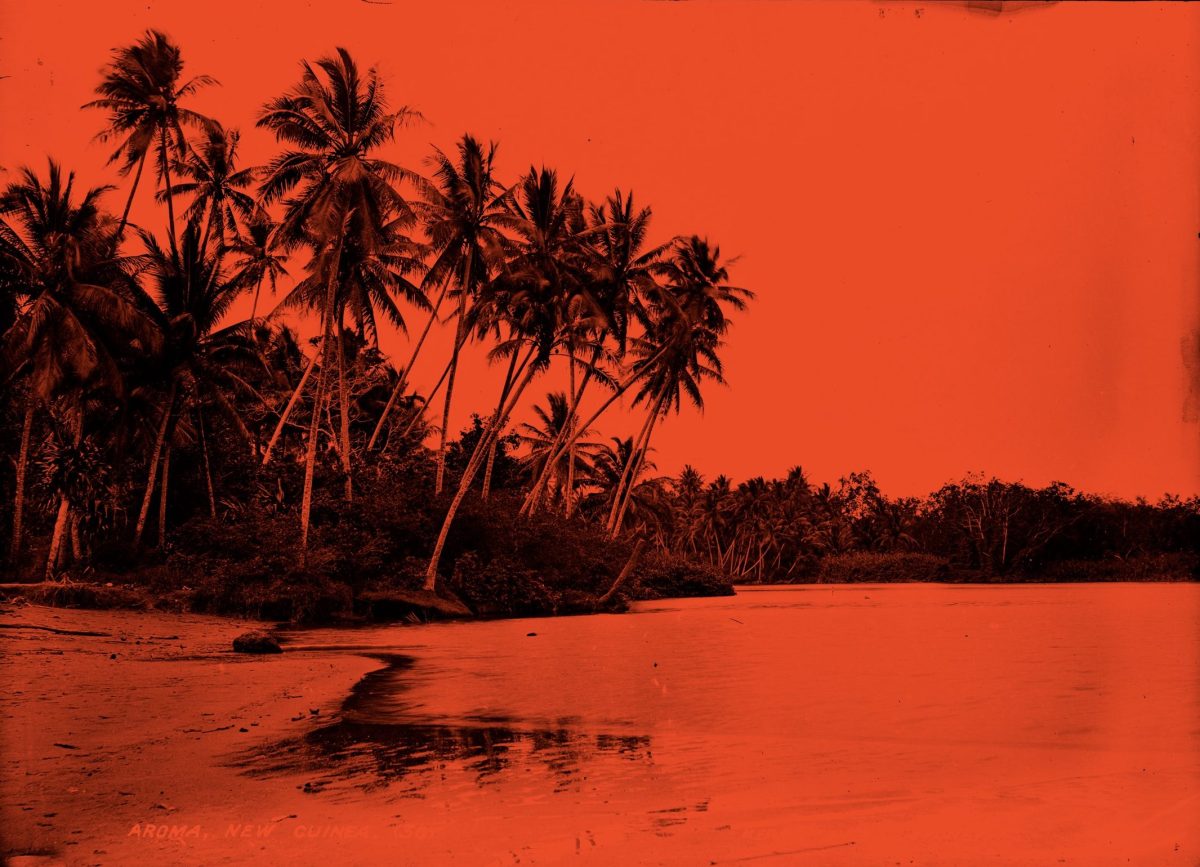‘Talanoa is a Pan Pacific word that means to have a free, open and transparent conversation,’ explains interdisciplinary Sāmoan artist Yuki Kihara.
Kihara has adopted the term for the forthcoming gathering, Talanoa Forum: Moana Rising, which will bring together 26 artists, curators, scholars, activists and policymakers from Australia, Aotearoa New Zealand, Sāmoa, Tahiti and Italy, for what she describes as a ‘gutsy’ conversation.
‘I really wanted to use this opportunity to bring everybody together in a face-to-face conversation to talk about these really gutsy, and often awkward, issues,’ Kihara tells ArtsHub. ‘We can only do so much over email and Zoom, and in order to address these issues – and perhaps find solutions – we really need to be in the same room.’
It was a view shared by Sāmoan/Pākehā arts writer and curator, Ioana Gordon-Smith: ‘The speakers gathered together include people who I myself look up to and have admired for a long time. To hear them speak in person, and in conversation together, is such an amazing opportunity – something that doesn’t come up every day.’
Aotearoa-based, Gordon-Smith will be joined by Prof Katerina Teaiwa (Australia) and Francesca Tarocco (Italy) as provocateurs over the three-day event.
How a talanoa works
Kihara says that a talanoa isn’t based on box-ticking or concrete outcomes. Rather, she describes it as a catalyst to action things. ‘I want to destabilise the power structures of academia, which I feel is really hierarchical. So, I have curated the speakers from a range of backgrounds and lifestyles – from community organisers, to activists, to artists and writers, to lawyers and scholars.’
Gordon-Smith adds: ‘Conferences and symposia often heavily feature speakers who come from countries like New Zealand, to then represent the Moana art at large. In the talanoa forum, the speakers also include those from different homelands and participants across geographical divides. To have all these people in the same room is a rare treat.’
Talanoa participants include: dancer Daniel Mateo, writer Francesca Tarocco, Punake body-centred performance artist Latai Taumoepeau, creative producer Leo Tanoi, arts trust director Aanoali’i Rowena Fuluifaga, architect and painter Miriama Bono, Pacific customary music specialist Tau’ili’ili Alpha Maiava, climate change advocate Fagalima Tuatagaloa and curator Professor Natalie King OAM – who took Kihara’s work to Venice for the Biennale – among others.
Kihara explains to ArtsHub: ‘When I say interdisciplinary, I mean it to be truly interdisciplinary in terms of dismantling the hierarchy. It’s a very different form to a traditional symposium, where you have to have an institutional affiliation to participate, or be enrolled in an institution for paid knowledge.’
‘The conversations are led and guided by the participants’ own concerns,’ Gordon-Smith adds.
Testament to that philosophy, Talanoa Forum: Moana Rising is free and anyone can attend, but you must register. It will be held over three days from 10-12 October and is hosted by Powerhouse Ultimo and the Chau Chak Wing Museum.
Jump to:

The gutsy topics to be discussed
When Yuki Kihara presented her Paradise Camp at the 59th Venice Biennale last year, holding a talanoa was a key component, to ‘ground it in the local,’ she says. Kihara wants to build on that momentum for Sydney.
‘The momentum really grew, particularly with the universities that we are partnering with; I think it just goes to show the Paradise Camp exhibition is a zeitgeist of the times on so many levels – it’s an intersectional approach to small island ecologies, queer identity and politics, climate change politics, decolonial museology – it’s really layered,’ says Kihara. ‘And I wanted to extend that to be in dialogue with the wider Pacific nations here.
‘What a talanoa forum does is that it actually makes these global issues more local. I often feel that when you address something very specific, it can be very universal,’ she tells ArtsHub.
To view the full program
Each day of the talanoa is themed, starting with ‘queering climate’, moving into diaspora communities on day two – remembering that half the world’s population of Sāmoans live in the diaspora and the arts is an integral part of maintaining connections to the homeland. And then rounding out the forum on day three, will be a discussion around Indigenous interventions within colonial collections to foster truth-telling.
In her own practice, Kihara uses the Sāmoan word va, which describes a space between binaries, to pair her art with the historical archive of the museum. Rethought as a Vārchive in Paradise Camp, this talanoa will leapfrog from Kihara’s use to contemplate the need to redefine heritage practices by encompassing Indigenous communities and sites as memory holders, which are increasingly threatened by climate change.
Climate will also be explored as another binary, when considering its implications for Sāmoa’s Faʻafafine/Faʻatama community. Kihara explains: ‘In Sāmoa we recognise an Indigenous third gender and, together, we have a full culture. But we’re not legally recognised. So, when natural disasters occur as a result of climate change and global warming, like tsunamis, coastal erosion and sea level rise, and cyclones, there is a rush for aid. But because the Faʻafafine/Faʻatama community is not legally recognised, we can’t access a lot of the support.
‘My argument is that the reason we have been a resilient island for the last 3000 years is because all of the four genders work in unison. But because of the introduction of colonial heteronormative gender norms, which only recognise two genders, it actually interferes with our resilience that acknowledges all genders.’ Kihara continues, ‘So when you take two genders out of the equation, there is a shift in the power balance to how we actually move forward as a post-colonial nation.’
Each day of the talanoa will also feature performances by Cindy of Sāmoa – the country’s number one female impersonator – with programs moving to the Chau Chak Wing Museum at the University of Sydney on day two, to coincide with its Pacific exhibition, Tidal Kin – Stories from the Pacific.
Gordon-Smith concludes: ‘I can’t wait for Powerhouse Late and to see the legend that is Cindy of Sāmoa!’ adding, ‘I also just can’t wait for the informal chats that happen between the formal program. Being there in person is vital; you never know what connections might emerge.’
How to register
The three-day program will be held 10-12 October, 10am to 5pm. To book, visit the website, email book@powerhouse.com.au or call (02) 9217 0222. Talanoa Forum: Moana Rising is supported by the University of Melbourne, Creative New Zealand and the University of Sydney.
Talanoa Forum Speakers
Aanoali’i Rowena Fuluifaga, Cindy of Sāmoa, Cristina Baldacci, Daniel Mateo, Fagalima Tuatagaloa, Fleur Ramsay, Prof Francesca Tarocco, Harold Samu, Ioana Gordon Smith, Prof Jioji Ravulo, Prof Katerina Teaiwa SFHEA, Latai Taumoepeau, Leo Tanoi, Madeline Poll, Miriama Bono, Natalie King, Nathan Mudyi Sentence, Noma Sio-Faiumu, Rosanna Raymond, Sefa Enari, Tammi Gissell, Tau’ili’ili Alpha Maiava, Thelma Thomas (MC Trey), Yuki Kihara
The exhibition Paradise Camp by Yuki Kihara, continues at Powerhouse Ultimo until December 2023. The exhibition will then tour to Sāmoa in June through to October 2024, to coincide with the 62nd anniversary of Sāmoa’s Independence.





